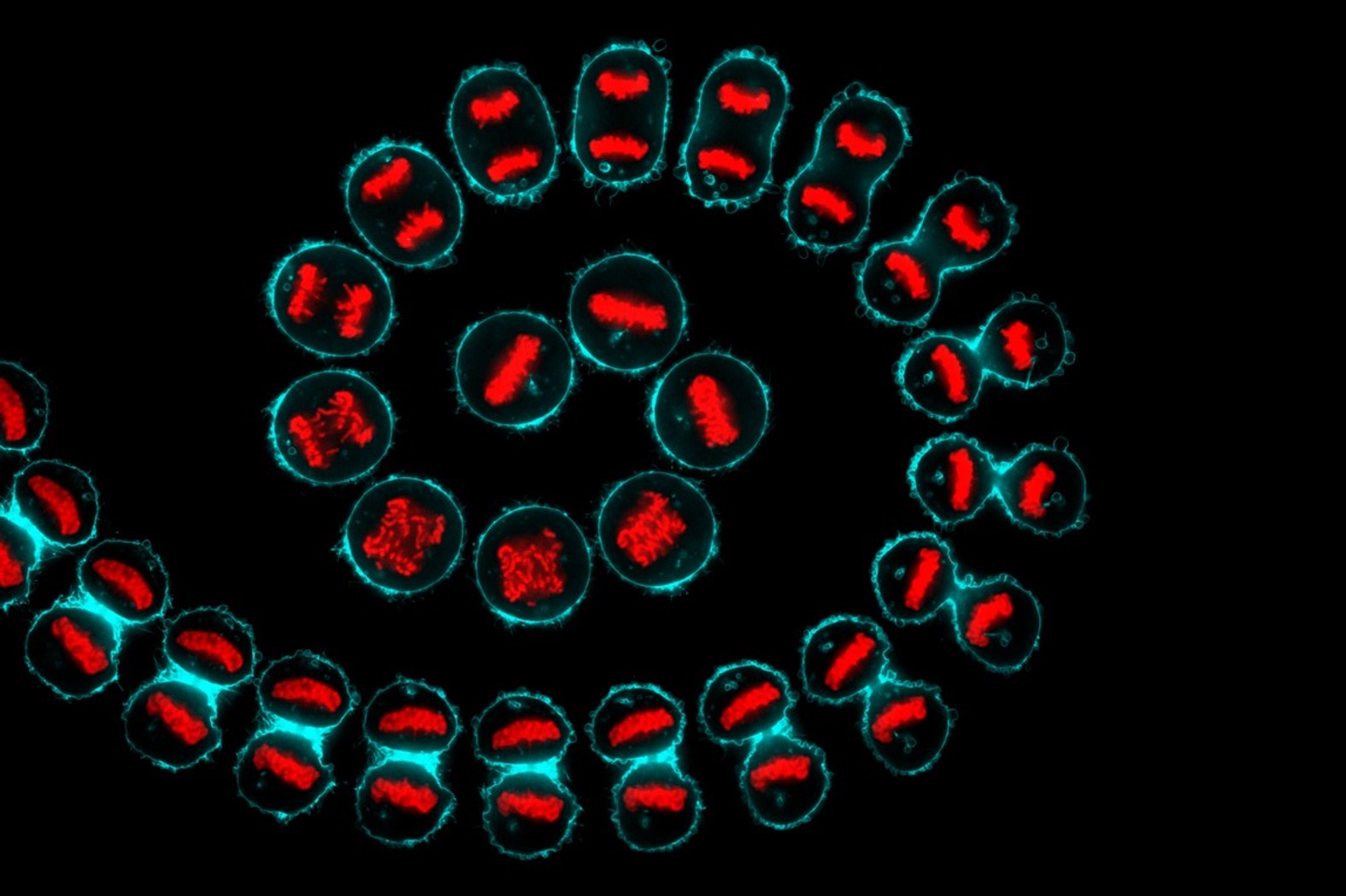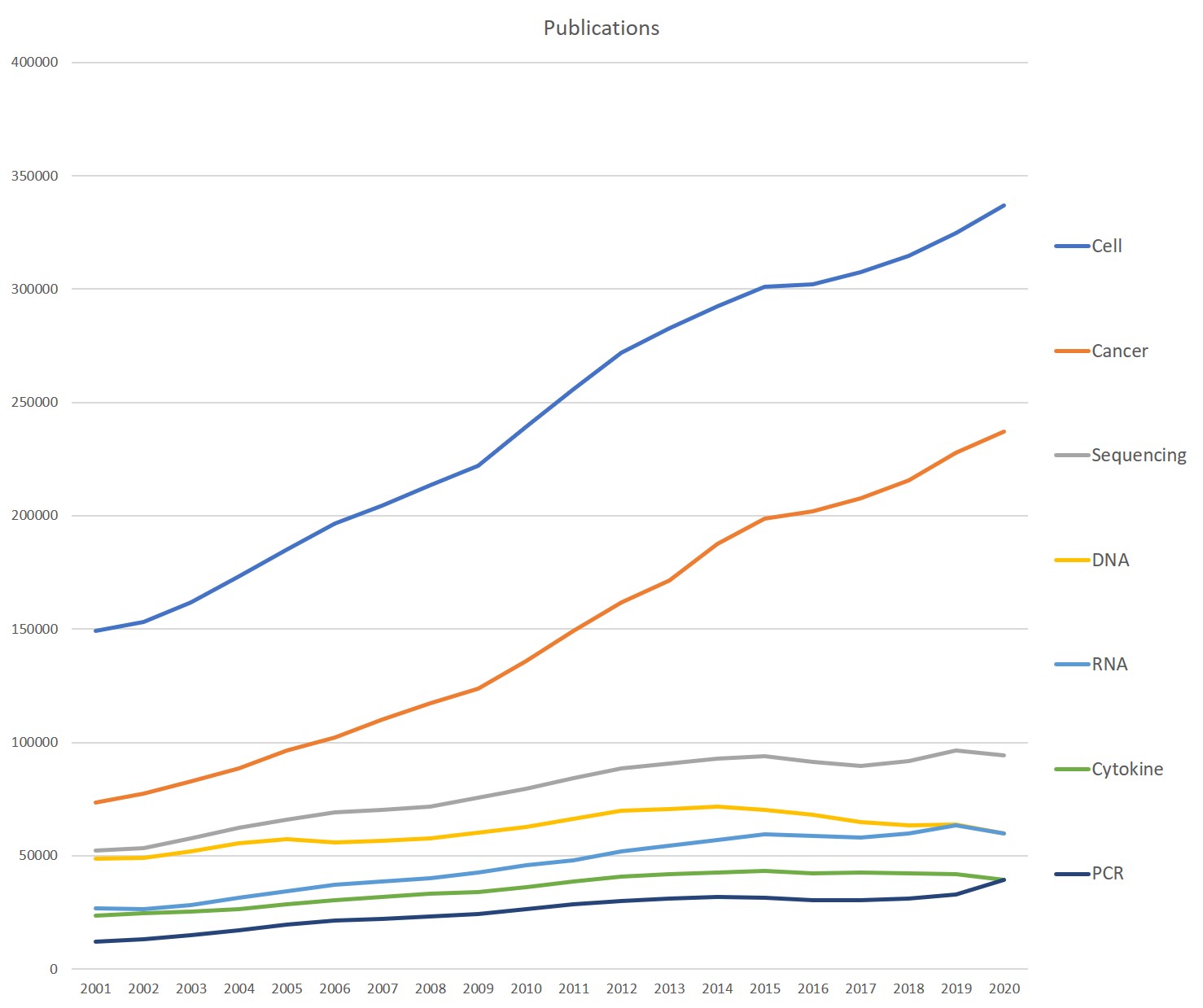Shifting focus: research topics and trends of the last 20 years

Biological discovery and crisis can both give rise to entirely new fields of study. In this article, we assess the impact of Covid on research output in 2020 and the rise of technologies such as CRISPR and cell reprogramming that have shaped the last 20 years. Some of these technologies have only recently emerged, a few have spawned huge fields of research and others appear to be in decline.
In order to gain an overall view of the publication output, we plotted publications returned by PubMed searches for terms associated with life science research. The overall picture for scientific publication shows a huge increase in output over the last two decades. Taking publications that simply mention the word “cell” as a general indicator of volume; this has grown 126% over the last 20 years. This increase has been driven by the proliferation of new research journals, an increasing requirement for PhD students to publish, the ambition of teaching universities to become research universities and the increased expenditure on research, particularly in rapidly developing economies notably China. But perhaps the biggest contribution is the proliferation of digital journals with low overheads competing for publication fees and inevitably driving standards down. The topic of publication proliferation is discussed in detail here.

The overall increase in “cell” publications (up 126%) runs parallel to an increase in “cancer” publications (up 223%) with remarkably parallel growth tracks. Cancer research seems to be the biggest driver of life science research activity. Researcher into other disease areas although growing too lags far behind.
The last two decades have seen a strong rise in RNA-related research which has long lagged behind DNA. Interest in “DNA” (up 23%) has been outpaced by a rapid increase in “RNA” publications (up 123%). The related molecules have almost exactly matched each other for publications in 2019 and 2020 with RNA likely to move ahead for the first time in 2021.

2020 publications by search term
A pronounced dip during 2020 for publications mentioning “sequencing", "cytokine", "DNA" and "RNA” may reflect generally lower research output in 2020 as the Covid pandemic restricted lab access. This may also reflect, at least in part, a diversion of research resources towards Covid which garnered 80,337 publications in 2020 compared to just 32 in 2019. This is a remarkably rapid redirection of research resources towards a virus that only emerged in the last quarter of 2019.

Interest in immunotherapy has grown apace since the turn of the century helped in large part by the clinical success of immune blockade inhibitors and CAR-T therapies. In contrast, interest in “RNA therapeutics” seemed to wane in 2020 although this may specifically due to reduced publication output for “siRNA” where publication growth has faltered since 2013. Other RNA-based therapies look set to rekindle the overall interest in “RNA therapeutics” with RNA vaccines set to be a hot topic in 2021 (see below) following the phenomenal success of Moderna and Pfizer/BioNTech’s RNA covid vaccines.
Interest in cytokines and chemokines has been in decline in recent years. However, like a volatile tech stock, current performance can’t be taken as a guide to the future. “Monoclonal antibodies” suffered a significant dip in publication volume from 1993-2003 but took off again in 2009 as second-generation antibodies such as bi-specific antibodies emerged.
Extracellular vesicles and their most famous family member, exosomes, have emerged since 2010 as an important research field in their own right with applications in therapeutics, drug delivery and diagnostics. Many labs are focussing on cancer and regenerative medicine.
Two powerful technologies that enable the manipulation of cells have fostered widespread research activity. CRISPR, a gene-editing technique, emerged around 2010. The ease and accuracy with which CRISPR allows genetic manipulation is transforming broad areas of medical research.
Similarly, interest in iPSC technology, which emerged less than 5 years before CRISPR in 2006 and allows the reprogramming of differentiated cells back to their pluripotent embryonic origins, continues to grow.
Organoids are also worthy of note with a relatively modest showing in terms of publications at present which looks set to increase rapidly if current growth rates and levels of interest are a guide. The potential of organoids to increase the power and utility of in-vitro assays is set to transform basic research and drug discovery in the next decade.

Looking at growth in terms of the proportion of papers published on a topic in each of the last 20 years, rather than actual publication count, a slightly different picture emerges of areas of research that are growing most rapidly. Topping the list is “RNA vaccines” which has emerged from relative obscurity in 2019. The total number of “RNA Vaccine” publications (88) was still very low. Perhaps more remarkable is the continuing surge in interest in exosomes and extracellular vesicles with the latter term first appearing in the literature in 2007. The data for "exosomes" is confused by the same name unfortunately being applied to “exosome complex”, a completely unrelated structure.
Looking to the future, wew technologies and fields of research emerge with remarkable regularity. One area to watch for the future is assembloids (distinct organoids which assemble into functional multi-organoid structures). We will be covering these in a future blog article.
IMAGE Cytokinesis by Kuan Chung Su

